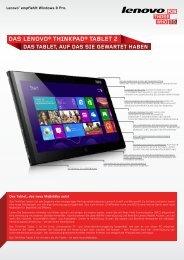Create successful ePaper yourself
Turn your PDF publications into a flip-book with our unique Google optimized e-Paper software.
Playing sound<br />
Your projector might have one or more audio-input connectors. To project sound, you will need to attach the<br />
combo audio jack on your computer to these connectors, using an audio cable (commercially available).<br />
Using dual displays<br />
Using the Extend desktop function<br />
Your computer supports a function named the Extend desktop. With the Extend desktop function, you<br />
can display output on both the computer display and an external monitor. You can also display different<br />
desktop images on each monitor.<br />
You can use the Extend desktop function without changing any settings. If the function does not work, refer<br />
to “Enabling the Extend desktop function” on page 76 to enable it.<br />
Considerations for using the Extend desktop function<br />
• If you want to show DOS full-screen while in the Extend desktop mode, only the primary display shows<br />
DOS; the other display is blacked out.<br />
If your computer has the Intel display adapter, you can designate the other display as the primary display<br />
by doing the following:<br />
1. Press Ctrl+Alt+F12. The Intel CUI window opens.<br />
2. Select Extended Desktop.<br />
3. Change the setting to designate the primary display.<br />
• When an application using the DirectDraw or the Direct3D is played in full-screen mode, it is shown<br />
only on the primary display.<br />
• You cannot use the display switching function when you are in the Extend desktop mode.<br />
Enabling the Extend desktop function<br />
To enable the Extend desktop function, do as follows:<br />
For Windows 7:<br />
1. Connect the external monitor to the monitor connector; then connect the monitor to an electrical outlet.<br />
2. Turn on the external monitor.<br />
3. Press Fn+F7, then select Extend.<br />
To change the resolution for each monitor, do as follows:<br />
1. Right-click on the desktop, and click Screen resolution.<br />
2. Click the Monitor-1 icon (for the primary display, the computer display).<br />
3. Select the Resolution of the primary display.<br />
4. Click the Monitor-2 icon (for the secondary display, the external display).<br />
5. Select the Resolution of the secondary display.<br />
6. Place the icons for the monitors so that they touch.<br />
Note: You can set the monitors in any relative position, but the icons must touch each other.<br />
7. Click OK to apply the changes.<br />
Note: To change the color settings, right-click on the desktop, and click Screen resolution. Click Advanced<br />
Settings, select the Monitor tab, then set Colors.<br />
76 <strong>User</strong> <strong>Guide</strong>

















